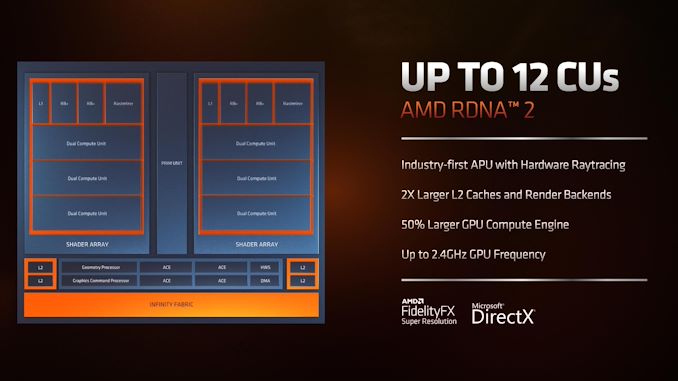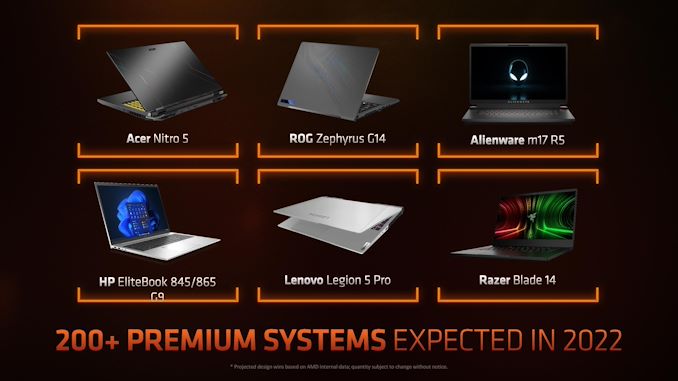AMD Announces Ryzen 6000 Mobile CPUs for Laptops: Zen3+ on 6nm with RDNA2 Graphics
by Dr. Ian Cutress on January 4, 2022 10:43 AM EST-page-011 - Copy_678x452.jpg)
The notebook market is a tough nut to crack with a single solution. People want that mix of high performance at the top, cost effectiveness at the bottom, and throughout there has to be efficiency, utility, and function. On the back of a successful ramp last year, AMD is striking the notebook market hot again in 2022 with the launch of its new Ryzen 6000 Mobile processors. These ‘Rembrandt’ APUs feature AMD’s latest RDNA2 graphics, up to eight Zen3+ cores with enhanced power management features, and it uses TSMC’s N6 manufacturing process for performance and efficiency improvements.
It’s all in the Silicon: Rembrandt is the Code-Name
Yesterday AMD disclosed that they would be launching the new Ryzen 6000 Mobile series today – updated cores, better graphics, more features, all in a single monolithic package a little over 200 mm2. There will be 10 new processors, ranging from the traditional portable 15 W and 28 W hardware, up to 35 W and 45 W plus for the high-end gaming machines. AMD is expecting 200+ premium systems in the market with Ryzen Mobile in 2022.
| AMD Ryzen 6000 Mobile CPUs 'Rembrandt' on 6nm |
||||||
| AnandTech | C/T | Base Freq |
Turbo Freq |
GPU CUs |
GPU MHz |
TDP |
| H-Series 35W+ | ||||||
| Ryzen 9 6980HX | 8/16 | 3300 | 5000 | 12 | 2400 | 45W+ |
| Ryzen 9 6980HS | 8/16 | 3300 | 5000 | 12 | 2400 | 35W |
| Ryzen 9 6900HX | 8/16 | 3300 | 4900 | 12 | 2400 | 45W+ |
| Ryzen 9 6900HS | 8/16 | 3300 | 4900 | 12 | 2400 | 35W |
| Ryzen 7 6800H | 8/16 | 3200 | 4700 | 12 | 2200 | 45W |
| Ryzen 7 6800HS | 8/16 | 3200 | 4700 | 12 | 2200 | 35W |
| Ryzen 5 6600H | 6/12 | 3300 | 4500 | 6 | 1900 | 45W |
| Ryzen 5 6600HS | 6/12 | 3300 | 4500 | 6 | 1900 | 35W |
| U-Series 15W-28W | ||||||
| Ryzen 7 6800U | 8/16 | 2700 | 4700 | 12 | 2200 | 15-28W |
| Ryzen 5 6600U | 6/12 | 2900 | 4500 | 6 | 1900 | 15-28W |
At the heart of the design is AMD’s Zen 3+ core, which affords an improvement in power management between the cores, but keeps the Zen 3 performance characteristics. The focus here is mainly to improve idle power consumption and power when using accelerators, to help extend the life of ultraportable devices – AMD is claiming 15-40% lower power between web browsing and video streaming. There is a frequency uplift as well, with the top processors going up to 5.0 GHz. AMD is claiming up to 1.3x Multi-thread performance for the Ryzen 7 6800U.
This is coupled with 12 compute units of the RDNA2 graphics engine, upgraded from eight Vega units. This is the widest integrated graphics engine that AMD has ever made, with both a +50% increase in units but also a fundamental change in the GPU design - double the graphics cache, double the rasterization performance, double the render backend, and hardware-accelerated ray tracing. The frequency also gets a +20% bump from 2.0 GHz to 2.4 GHz. In gaming performance at 15 W on 5800U vs 28 W at 6800U, AMD is claiming a 1.8-2.0x jump over the previous generation*, and anywhere from 1.2x to 3.0x at 1080p against the competition. Adding on FidelityFX Super Resolution, and AMD suggests another +20-60% in frame rates. This, combined with the memory improvements, should be good for integrated gaming. GPU Rendering performance according to AMD is up to 2.3x faster generationally, but it should be noted however that the GPU does support AV1 decode, both 8-bit and 10-bit streams.
* It should be noted AMD tested the 6800U at 28W nominal TDP, not 15 W
** We originally stated that Rembrandt did not support AV1 based on our interpretation of one of the slides from AMD - we have since confirmed that the chips do support AV1 decode, both 8-bit and 10-bit, supported by AMD's VCN IP inside the chip.
When paired with AMD’s new mobile graphics solutions, the 35W+ series of Rembrandt can feature AMD’s Advantage platform. The idea is that with an A+A design, the system can use SmartShift Max which allows for dynamic power adjustment between CPU and discrete GPU, leading to more performance. This can also be used to extend the battery life, or combined with AMD SmartAccess graphics, can be used to ensure the best GPU is used at all times.
The new Rembrandt CPUs will also feature updated memory controllers, with support up to DDR5-5200 and LPDDR5-6400 – it’s worth noting that there doesn’t seem to be DDR4 support here, thus making a clean cut to the DDR5 standards. (Ian: that might mean increased cost during the first few months of these products.) AMD has also increased from PCIe 3.0 to PCIe 4.0, supporting 8x for a discrete GPU and 12x split between NVMe, SATA, and chipset. There is also native support for USB4, which allows vendors to follow Thunderbolt 3 specifications if needed.
On accelerators and security, Rembrandt features Microsoft Pluton support, which has been in the pipe for a couple of years as a way to enable coupled security between system, the OS, and potentially the cloud. Features like protecting user memory are welcome, however there have been concerns that Pluton opens more doors than it closes, depending on your jurisdiction. On a lighter note, according to details in the firmware and open source drivers, Rembrandt will also include computer vision-based machine learning hardware – a pair each of the Tensilica Vision Q6 and C5 DSPs, which should offer more functionality around laptop cameras when put to good use. These sorts of mobile APUs also end up in embedded systems, such as augmented reality or automotive, which could extend the offering there.
On this announcement, it’s interesting to see that most of the comparison numbers AMD supplied to us were for the 15 W hardware, however 80% of the CPUs being launched today are focused more at the 35W and higher space. It will be interesting to see how the 35W+ performs by comparison, given that at 35W+ we expect to see most systems with a discrete GPU, and most of the Rembrandt enhancements were in the integrated graphics. Nonetheless, we’re going to see a lot of systems using Ryzen 6000 Mobile announced this week – AMD states that some of these should start going on sale around February.














77 Comments
View All Comments
gijames1225 - Tuesday, January 4, 2022 - link
So with these supporting USB 4, do we finally have mass Thunderbolt support on AMD notebooks now?Either way, really exciting set of technologies, and I hope to get a ROG Zephyrus 14 or 15 later in the year.
Tams80 - Tuesday, January 4, 2022 - link
I'm hoping for an updated Flow device. All AMD, including in the eGPU dock would be nice.But it seems Asus is only interested in an Intel tablet in that range this year.
nandnandnand - Tuesday, January 4, 2022 - link
I think it's technically optional to have Thunderbolt 3/4 with USB 4, but likely: https://en.wikipedia.org/wiki/USB4Dahak - Tuesday, January 4, 2022 - link
argg... ffs... if its usb4 it should have all of TB3, none of this semi support.I miss the days when a spec meant all features. none of this crap where oh its usb4 but only support usb 3.2 data and nothing else
Same with the new HDMI 2.1/a spec ... oh the tv is labeled with the 2.1 spec but only supports the 2.0 features..... argg...
sorry for the mini rant
anonymfus - Tuesday, January 4, 2022 - link
I think you are misunderstanding USB4. It's inspired by Thunderbolt and has all features of Thunderbolt, but it is not Thunderbolt, and the USB4 specification only mandates TB3 backward compatibility for hubs, not for hosts/devices, and otherwise threats TB3 as a deprecated predecessor.futurepastnow - Friday, January 7, 2022 - link
Oh of course it's optional. Why would the USB-IF try to make this easy?blanarahul - Tuesday, January 4, 2022 - link
“ AMD has also increased from PCIe 3.0 to PCIe 4.0, supporting 8x for a discrete GPU.”Really? Only 8x? They do realize that laptop GPUs have to send the frame buffer back to CPU right?
hecksagon - Tuesday, January 4, 2022 - link
A frame of 4k with 32 bits per pixel is only 33 MB. At 120hz that's under 4 GB/s, well under the 16 GB/s that 8 lanes of PCIe Gen 4 give you.Billy Tallis - Tuesday, January 4, 2022 - link
And PCIe is full-duplex, so sending data back to the CPU doesn't subtract from the available throughput for transfers from CPU to GPU.Spunjji - Wednesday, January 5, 2022 - link
That wasn't a problem with PCIe 3.0 16x, why would it become one now?